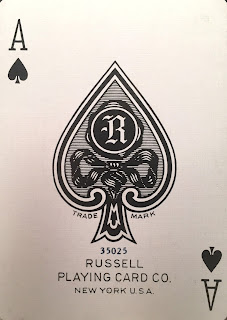 |
| R.W. Hull Green Ace Playing Card - this is actually the back design of a full deck of cards. |
Delving into Hull's history, I found a rich biographical record: Ask Alexander produced nearly 1,000 references in magic books and periodicals, and the Internet revealed still more. There is far too much material for a detailed biography, so a few highlights will have to do:
 |
| Face of green Hull throwing card |
Touring the country during his 20s, Ralph developed an original magic act which he performed as a headliner in Chautauqua & Lyceum, as well as in Coney Island. He was a prolific magic writer who penned a number of books, including Eye-Openers (1932), Modernism in Pasteboard (1934), Smart Magic (1935) and Fifteen Minutes With A Rope (1937).
 |
| Hull frequently partnered with magic dealer John Snyder in creating new effects. |
But it was as a magical inventor that Hull made his greatest mark. His prodigious skill prompted William F. Baker (who wrote often under the pseudonym "Old Timer") to observe in the Linking Ring in 1936 that Hull "leads all others in new, ingenious card magic." Hull released countless commercial effects, One report suggests that he released 50 commercial card effects in 1934 alone, all of which were well reviewed.
 |
| Sporting a Filigree Pattern Back from Russell's Blue Ribbon Deck |
Without question, though Hull's piece de resistance was the Tuned Deck, about which John Northern Hilliard wrote in Greater Magic:
The explanation provided by Hull, which takes up some dozen pages of Greater Magic, (followed by a two-page cheat sheet for performers) essentially consists of six different methods of card location, which methods are continually varied so as to utterly perplex the spectator. Hull's diabolical method rotation allows for multiple repetitions of the trick that enhance its mystification -- each method establishes the the prior method was not that used to achieve the effect. I will not tip the methods here, as, to quote Hull, he placed it in Greater Magic to ensure that his "most cherished trick [will] fall only into such hands as should have it.""FOR many years Mr. Ralph Hull, the famous card wizard of Crooksville, Ohio, has completely bewildered not only the general public, but also amateur conjurers, card connoisseurs and professional magicians with the series of card feats which he is pleased to call "The Tuned Deck." So great has been the interest aroused by Mr. Hull's masterly performance of his card creation that he has finally consented to reveal its secrets in my book. I am proud to be able to present to my readers the correct and only explanation of the trick in Mr. Hull's own words."
 |
| Ralph W. Hull |
That the tale of the Tuned Deck can be found at the core of an academic debate about the fundamental nature of consciousness among neuroscientists is just another unexpected turn in the twisted tale about the Man from Crooksville. I unearthed this gem from a learned treatise entitled The Three-pound Enigma: The Human Brain and the Quest to Unlock Its Mysteries, which describes the work of Dr. Daniel Dennett, a philosopher and cognitive scientist. In exploring the nature of consciousness, essentially the question of whether we can truly understand and describe self-awareness, Dennett invokes the story of R.W. Hull's use of the Tuned Deck to flummox other magicians by repeating the trick multiple times but changing the method each time. From this, Dennett concludes that "consciousness is a bag of tricks."
For readers who might be thinking that there's enough material here to write a book, well, there is one. Captain Treyor H. Hall, a frequent correspondent of Hull's who never got to meet him, authored The Testament of Ralph W. Hull. In it, Hall observes:
"Magic can ill-afford the loss of Ralph Hull. In this tribute 1 have tried to indicate the very considerable extent of that loss, and to measure the debt of gratitude which we owe to one who has helped to make possible the recent enormous technical advance in the science of magic, and especially the magic of cards."
When I recently encountered and purchased Hull's throwing card, a fine, amusing specimen, I knew nothing of the magical genius it purported to promote. The card just seemed funny and attractive. Hull's story proved even more engaging. And to quote my friend and co-blogger Tom Ewing, "Who wouldn't want to have come from Crooksville?" .
Truth be told, I have no interest in cards. But I do have interest in histories and mysteries.
ReplyDeleteWhich is a fantastic thing.
You see, the thing is...
I had thought that the blogspot platform is dead - filled with junk blogs and all worth not.
This is in comparison to huge blogging communities like WordPress and Overblog.
But guess what?
I was wrong.
The other day, I discovered the Grumpy Economist. And then a hidden news discussion platform. And then your blog.
And what of "The 100 Reasons Not to Go to Graduate School"?
Oh boy...
I feel like doing a huge list of you guys right now. It's just that the niche of my blog wouldn't allow that.
Maybe, I will create a blog for that.
Keep up being awesome!
Lawrence
ReplyDeleteThanks for your kind endorsement. I know that I speak for the entire team here when I say that yours is exactly the kind of reaction we hope for. Writing this blog has been a fair amount of work, but it's been great fun, and we've been able to unearth some amazing gems, while making some really cool connections among fans, collectors and historians. We'll do our best to keep the awesome coming!
Daniel Dennett's book "I've been thinking " pg. 91 about the hard problem of consciousness was demystified by the card trick, the tuned deck. Really a wonderful book by Dennett and his last. See him on youtube.
ReplyDelete